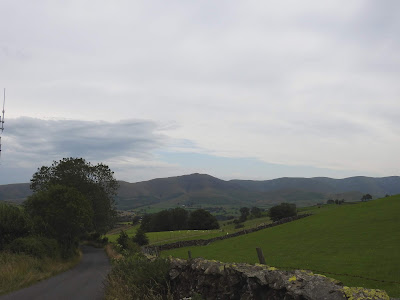Close bosom-friend of the maturing sun;
Conspiring with him how to load and bless
With fruit the vines that round the thatch-eves run;
To bend with apples the moss'd cottage-trees,
And fill all fruit with ripeness to the core;
To swell the gourd, and plump the hazel shells
With a sweet kernel; to set budding more,
And still more, later flowers for the bees,
Until they think warm days will never cease,
For Summer has o'er-brimm'd their clammy cells.
As you will probably know the above is the first verse of one of my favourite poems, 'Ode To Autumn', by John Keats. It is so evocative of Autumn, which of course it is meant to be, and I love all the bird references contained therein. On Bank Holiday Monday morning as I drove to one of the reedbeds at the Obs it most certainly was season of mists as one of those low autumnal mists carpeted the farm fields. I was meeting Alice and Ian at 5:30 am, and it didn't bode well for our impending ringing session.
I was there first and as I waited for Alice and Ian to arrive I could hear Swallows exiting their reedbed roost giving that exquisite twittering that I think sounds more urgent in Autumn, or is that just me thinking about the season? It was impossible to tell how many because of the mist, but there was a fair few.
Next up were the Starlings and they were visible and numbered at least ten thousand. The noise from their wings always reminds of waves rolling on to the shore. Superb!
Who hath not seen thee oft amid thy store?
Sometimes whoever seeks abroad may find
Thee sitting careless on a granary floor,
Thy hair soft-lifted by the winnowing wind;
Or on a half-reap'd furrow sound asleep,
Drows'd with the fume of poppies, while thy hook
Spares the next swath and all its twined flowers;
And sometimes like a gleaner thou dost keep
Steady thy laden head across a brook;
Or by a cyder-press, with patient look,
Thou watchest the last oozings hours by hours.
The mist certainly did have a negative impact on our ringing session, and indeed on any migration monitoring at the Obs at all, by way of preventing any vis. It certainly 'felt' very quiet in the reeds and scrub as we put the nets up. We did manage to ring twenty birds, which was a bit of a bonus considering the conditions. The twenty ringed were:
Reed Warbler - 3
Blackcap - 7
Cetti's Warbler - 1
Great Tit - 1
Lesser Whitethroat - 2
Whitethroat - 2
Wren - 1
Chiffchaff - 1
Long-tailed Tit - 1
Blue Tit - 1
Cetti's Warbler
Lesser Whitethroat
A few bird calls drifted through the mist including Sandwich Tern and Whimbrel, but how many? After a couple of hours we decided to cut our losses and call it a day.
I'll leave the final words to John Keats!
Where are the songs of Spring? Ay, where are they?
Think not of them, thou hast thy music too -
While barred clouds bloom the soft-dying day,
And touch the stubble-plains with rosy hue;
Then in a wailful choir the small gnats mourn
Among the river sallows, borne aloft
Or sinking as the light wind lives or dies;
And full-grown lambs loud bleat from hilly bourn;
Hedge-crickets sing; and now with treble soft
The red-breast whistles from a garden-croft;
And gathering swallows twitter in the skies.


















